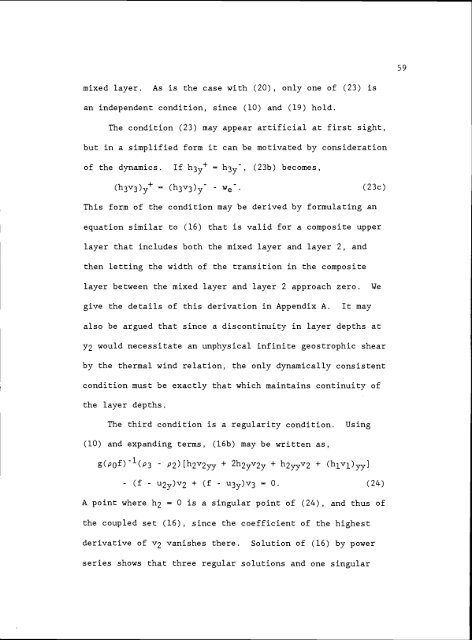Observations and Modelling of Fronts and Frontogenesis
Observations and Modelling of Fronts and Frontogenesis
Observations and Modelling of Fronts and Frontogenesis
Create successful ePaper yourself
Turn your PDF publications into a flip-book with our unique Google optimized e-Paper software.
mixed layer. As is the case with (20), only one <strong>of</strong> (23) is<br />
an independent condition, since (10) <strong>and</strong> (19) hold.<br />
The condition (23) may appear artificial at first sight,<br />
but in a simplified form it can be motivated by consideration<br />
<strong>of</strong> the dynamics. If h3y = h3y, (23b) becomes,<br />
(h3V3)y+ (h3v3)y we (23c)<br />
This form <strong>of</strong> the condition may be derived by formulating an<br />
equation similar to (16) that is valid for a composite upper<br />
layer that includes both the mixed layer <strong>and</strong> layer 2, <strong>and</strong><br />
then letting the width <strong>of</strong> the transition in the composite<br />
layer between the mixed layer <strong>and</strong> layer 2 approach zero. We<br />
give the details <strong>of</strong> this derivation in Appendix A. It may<br />
also be argued that since a discontinuity in layer depths at<br />
i<br />
would necessitate an unphysical infinite geostrophic shear<br />
by the thermal wind relation, the only dynamically consistent<br />
condition must be exactly that which maintains continuity <strong>of</strong><br />
the layer depths.<br />
The third condition is a regularity condition. Using<br />
(10) <strong>and</strong> exp<strong>and</strong>ing terms, (l6b) may be written as,<br />
g(p0f)1(p3 p2)[h2v2 + 2h2yv2y + h2v2 + (h1v1)]<br />
(f u2y)v2 + (f - u3y)v3 0. (24)<br />
A point where h2 - 0 is a singular point <strong>of</strong> (24), <strong>and</strong> thus <strong>of</strong><br />
the coupled set (16), since the coefficient <strong>of</strong> the highest<br />
derivative <strong>of</strong> v2 vanishes there. Solution <strong>of</strong> (16) by power<br />
series shows that three regular solutions <strong>and</strong> one singular<br />
59















